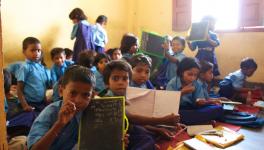Delhi University: New Workload Norms to Hit SC, ST Students Most, Say Teachers

New Delhi; The newly released workload norms by Delhi University have triggered concerns over “dilution” in the quality of education imparted to students, as the crumbling infrastructure does not have the capacity to bear the increased load, say teachers.
According to the notification released by University of Delhi, the new classroom size for undergraduate courses shall consist of 60 students, and 20 students each for tutorials and practicals, respectively.
For post-graduate courses, 50 students can attend the lectures while minimum 20 students are to be allowed for practical and tutorials. The General Elective Courses, Skill Enhancement Course and Value Addition courses can taught to groups of 20 to 60 students. The notification further added that in undergraduate courses, minimum students for any course shall be 20. In case, adequate students are not available, the cluster of colleges shall be used for the teaching and learning process.
Cluster colleges are those centres where students can study their options if their choice is not available in their own institutions.
However, the new regime has been heavily criticised by students bodies, too, who alleged that it will unnecessarily increase the travel time.
The new workload norms have come under fire from teachers who said that students from Scheduled Castes, Scheduled Tribes (SC/ST) and other marginalised communities will suffer the most and the chances of them dropping out are likely to further increase.
Rudrashish Chakraborty, associate professor at Kirori Mal College, who has been teaching English for two decades, told NewsClick that so far teachers could take care of students from marginalised communities because the tutorial class size was limited to 10 students.
“The students would come to us with specific questions and we could address them. How are we suppose to give them time when the university is prescribing a minimum class size for tutorial and practicals to 20. The students who could think of better lives after formal education in colleges will feel betrayed,” he added.
Chakraborty said that the students teacher ratio that was earlier prescribed by former education policies at 1:18 has been revised at 1:30 under the New Education Policy (NEP). Further the class size of honours courses has changed from 40 in choice-based credit system to 60 in Undergraduate Curriculum Framework in NEP.
“Changes have taken place without any academic debate or discussion and are being imposed by the university administration with scant regard for any academic merit. Moreover they are being done through notifications by the Registrar instead of being approved by the relevant statutory bodies, ie, the Academic and the Executive Council,” he added.
Abha Dev Habib, associate professor at Miranda House, told NewsClick over phone that the University Grants Commission has neither allocated funds nor new teachers for EWS (economically weaker sections) quota implementation. In this situation, swollen classes will be a matter of concern.
“We know of many colleges where students cannot take practical and tutorials in one go. Additionally, what skills can be imparted if the SEC and VAC papers, which are lab and tutorial-oriented, are to be taught to a class of 60 students,” she added.
Habib, also secretary of the Democratic Teachers Front, said that the number of teachers who would have come under EWS expansion has simply gone. “The students studying their masters and PhD in DU and other central universities will simply have very few opportunities to pursue their careers and head to private universities unfortunately,” she added.
Condemnation for the new norms also poured in from the Aam Aadmi Party-backed Academics for Action and Development Teachers Association (AADTA). Rajesh Jha, spokesperson, AADTA, said the notification for class/tutorial/practical batch size was a step toward ruining the academic and teaching learning process in university. Indirectly and slowly, the university is moving toward online mode of teaching. This is a clear reflection of less funding by the Central government and in conjunction with policy of NEP 2020, eh said.
“On the one hand, NEP provides diversity in paper selection/choice but at the same time it has restricted the choice. For instance, if the students' strength is less than 20 in a course, then they will visit cluster centres, and this will directly fluctuate the workload of any department in a college,” Jha added.
Sachin N, who teaches in Dayal Singh College, told NewsClick that the real impact of these changes would be on colleges located in far-flung places. “It may be easier for students to commute within North and South Campuses because they are closely located. Are the policy makers aware that students already travel up to 20 km to pursue their studies and their hopes for education would simply be hit when they are told to sit in overcrowded lectures and tutorials. We really do not know if cluster colleges too can bear the burden”, he said.
Delhi University Registrar Vikas Gupta remained unavailable for comment on the developments.
Get the latest reports & analysis with people's perspective on Protests, movements & deep analytical videos, discussions of the current affairs in your Telegram app. Subscribe to NewsClick's Telegram channel & get Real-Time updates on stories, as they get published on our website.
























